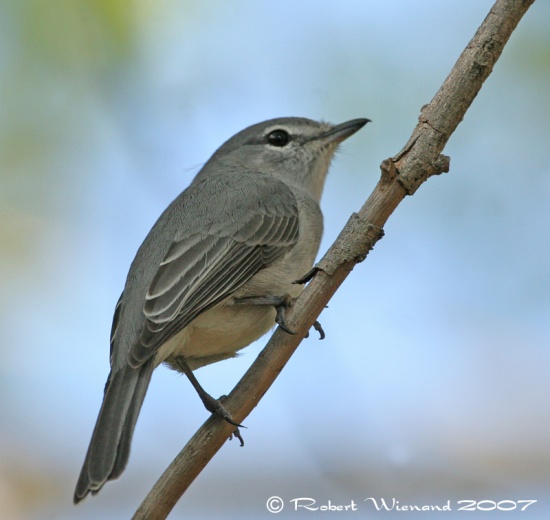(Added alternate name.) |
(→External Links: GSearch expanded) |
||
| Line 38: | Line 38: | ||
{{ref}} | {{ref}} | ||
==External Links== | ==External Links== | ||
| − | {{GSearch|"Muscicapa caerulescens" {{!}} "Fraseria caerulescens" {{!}} "Ashy Flycatcher" {{!}} "Ashy Alseonax"}} | + | {{GSearch|"Muscicapa caerulescens" {{!}} "Fraseria caerulescens" {{!}} "Ashy Flycatcher" {{!}} "Ashy Alseonax" {{!}} "Blue-grey Flycatcher"}} |
{{GS-checked}}1 | {{GS-checked}}1 | ||
<br /> | <br /> | ||
Latest revision as of 21:10, 2 November 2023
Alternative names: Ashy Alseonax, Blue-grey Flycatcher
- Fraseria caerulescens
Identification
14-16 cm (5½-6¼ in). A pale grey or blue-grey flycatcher of forest margins. The black loral line and the white supraloral streak which joins the narrow (but usually prominent) white eye-ring are good diagnostic features for this bird.
- elongate for a flycatcher, recalling a wheatear
- overall grey or brownish-grey. Often more bluish than similar species like African Grey Flycatcher
- loral line dark with whitish supraloral
- eye ring white or whitish, narrow but often prominent. Horizontally bisected
- throat whitish, often contrasting with grey underparts
- lower belly paler, becoming white in the vent area
- wing with pale feather fringes
- eye dark
- bill dark, frequently with paler base to the lower mandible (may appear light blue, even creamy)
- legs bluish grey (may be dark)
Distribution
Sub-Saharan Africa: Guinea to south-eastern Somalia, Angola and eastern South Africa.
Taxonomy
Formerly placed in genus Muscicapa
Subspecies
Clements recognises the following subspecies [2]:
- F. c. nigrorum: South-eastern Guinea to Sierra Leone, Ghana and Togo
- F. c. brevicauda: Southern Nigeria east to southern South Sudan, Uganda, and extreme western Kenya, south to northwestern Angola and southern Democratic Republic of the Congo
- F. c. cinereola: Southern Somalia to eastern Kenya and eastern Tanzania
- F. c. impavida: Southern Zaire to south-western Angola, far-northern Namibia, northern Botswana, western Tanzania and northern Mozambique
- F. c. vulturna: Southern Malawi to southern Zimbabwe and north-eastern South Africa
- F. c. caerulescens: Extreme southern Mozambique, southern eSwatini and south-eastern South Africa
Habitat
Dry and moist forests (where it prefers forest edge and clearings) and moist savanna.
Behaviour
The diet comprises mainly insects; hawked or taken on the ground. Also seen eating small fruit and small geckos.
Breeding
Monogamous and territorial. Both sexes build a cup-shaped nest using bark, grass, moss and rootlets (sometimes spiders web); it is placed in a shallow cavity in a tree or rock-face, or at a narrow fork between branches. Two to three cream, finely spotted eggs are laid and incubated for about 14 days. Parasitism by Klaas's Cuckoo has been recorded.
References
- Answers.com. 2008. Animal Encyclopedia: Ashy flycatcher. Downloaded 27 December 2008.
- Clements, J. F., T. S. Schulenberg, M. J. Iliff, D. Roberson, T. A. Fredericks, B. L. Sullivan, and C. L. Wood. 2017. The eBird/Clements checklist of birds of the world: v2017, with updates to August 2017. Downloaded from http://www.birds.cornell.edu/clementschecklist/download/
- Hockey, PAR, WRJ Dean, and PG Ryan, eds. 2005. Roberts' Birds of Southern Africa. 7th ed. Cape Town: John Voelcker Bird Book Fund. ISBN 978-0620340533
- Sinclair, I and P Ryan. 2003. Birds of Africa South of the Sahara. Princeton: Princeton Univ. Press. ISBN 978-0691118154
Recommended Citation
- BirdForum Opus contributors. (2025) Ashy Flycatcher. In: BirdForum, the forum for wild birds and birding. Retrieved 2 January 2025 from https://www.birdforum.net/opus/Ashy_Flycatcher
External Links
GSearch checked for 2020 platform.1





